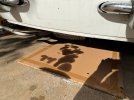Dave Bassett
True Classic
Good evening, my recently acquired Spider has oil leaks. the heavies leaking is from the very rear of the car but it actually leaks all around. The inside of the engine lid is clean as is the engine block. The timing chain cover is fairly dry above the crankshaft. The oil pan right under the centrifugal oil filter is very wet with clean oil. My question is: Should I start with the oil pan gasket and see what effect that has? Thank you.
P.S., Photos are coming.
P.S., Photos are coming.

